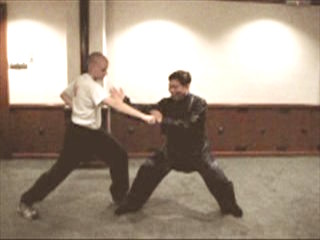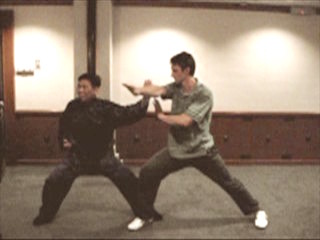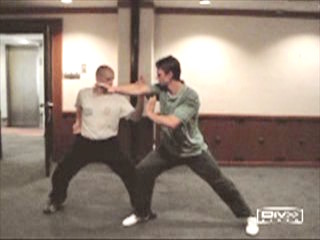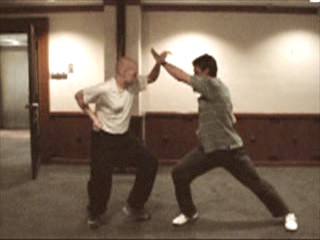APPLYING STRATEGIES FOR EFFECTIVE COMBAT

Daniel and Steve employ strategies in their attack and defence
Most people today fight haphazardly, i.e. their attacks or defences are impromptu and isolated. For example, they throw a punch or a kick without pre-planning. Their next attack is not related to their earlier movements. When their opponent attacks them, they think of how to respond or they react instinctively.
A systematically trained Shaolin practitioner does not fight in this haphazard way. First, he employs techniques appropriate for the combat situations. When an opponent attacks him, he does not hesitate to think of what to do; he already knows beforehand how to react correctly to various forms of attack.
Then he seeks or works out advantageous ways in his attack and defence using tactics and strategies. For example, instead of executing a kick straightaway, he may tempt his opponents to attack first, then kick when they least expects it. This is using tactics.
His attacks and defences are not executed in isolation, but flow in sequences. What sequences to use and what patterns are used in each sequence are planned beforehand. He may even plan so that his opponents, without being aware of it themselves, fight in a way he has planned. This is using strategies.
Some simple strategies in attack and defence are shown in these video clips. They involve various modes of applying combat sequences.
But what should you do if your opponents react outside the manner you have planned, which is usually the case in real fighting? (But a master can be so skillful in using strategies that his opponents actually fight the way he has planned) You make modifications, then resume your planned strategy. This aspect has actually been touched upon in earlier videos, and will be dealt with in later progression. The video series here records the stage where whole sequences without modifications are used.
Breaking the Attacker's Arm

Here Steve attacks Daniel with a pre-planned mode. But Grandmaster Wong intercepts to explain an important point. A pattern in Sequence 8 should be “Attend Conferrence with Single Knife” which is a chopping attack, instead of “Bar the Big Boss” which is a defence technique. The former is a counter-attack which breaks the attacker's arm whereas the latter deflects the attack.
Attending Conference with Single Knife

Grandmaster Wong shows the details of the application of the pattern “Attend Conference with Single Knife”. As Daniel attacks, Grandmaster Wongs “swallows” by sinking his stance backward but without moving his feet. This “swallowing” technique has avoided the attack. But before he counter-attacks, Grandmaster Wong has to push aside the attacking arm. But here he chooses to chop it instead.
The Strategy of Continuous Sequences

Steve attacks with a strategy. He initiates with Sequence 7 and continues with Sequence 8. He can make it confusing for the opponent by varying the second sequence. Daniel can defend against the attacks because he has been trained. Most untrained opponents would be at a lost when faced with continuous attacks executed as a strategy.
Intercepting to Break an Opponent's Arm, Not your own Fingers

Grandmaster Wong explains the fine points in intercepting a horizontal sweep. You need to sink back to a sideway Horse-Riding Stance so as to avoid the sweep even if you do not intercept it. When you intercept, you should ensure you use the edge of your palm, and not your fingers or else his sweep may break your fingers.. Your palm cuts into his upper arm or wrist to break it.
Having a Strategy in Attack or Defence

Steve's strategy is to attack with Sequence 8. Daniel continues with Sequence 7. Steve may use other sequences to attack, and Daniel may use other sequences to respond The important point here is that you must have a plan or strategy to attack, and a strategy to respond. This is certainly a big advantage over those who attack and defend randomly. In other words, if you have a strategy, even a simple one like those shown here, in your attack and defence you have a better chance of beating your opponent.
Fighting at Sequence-Level to Defeat Opponents

Steve's strategy is to attack with Sequence 7. As Daniel hesitates to respond, he continues with Sequence 8. This is planned before-hand. Steve does not pause at each pattern, or even at the end of a sequence to think what to do next. Before he attacks, he has in mind he is to use Sequences 7 and 8. At the end of Steve's second attacking sequence, Daniel responds with Sequence 7. As many people are not trained to fight at the sequence-level, if you apply your sequences flowingly, you have a good chance to defeat your opponents.
Applying Strategies for Effective Combat in Shaolin Kungfu from Wong Kiew Kit on Vimeo.
LINKS
How to Think and Act as a Master
- Returning to the Basics
- Form, Force, Flow and Element of Threat
- Reviewing the Basic Combat Sequences
- Devising Strategies Using Combat Sequences
- Applying Strategies for Effective Combat
- Free Sparring with Prescribed Conditions
- Combat Sequences to Train Spontaneous Attacks and Responses
- Using Strategies and Tactics in Attack and Defence
- It is Heartening to see so Many People Using Kungfu in Free Sparring
- Felling and Gripping Techniques in Shaolin Kungfu
- How Sequence Training and Chi Flow Enhance Combat Efficiency
- The Tiger-Crane Set — Manifesting the Hard and the Soft in Shaolin Kungfu
- The Dragon-Tiger Set — Crystallization of Two Wahnam Traditions
- The Dragon-Form Set — Demonstrating that Softness Can be Very Powerful
- Shaolin Monkey Set — Symbolizing Spiritual Path from Cheekiness to Enlightenment
- Shaolin Five-Animal Set — Gist of Shaolin Forms and Essence
- Shaolin Pakua Set Set — An Exclusive Set Fit for Kings and Generals
- Combat Application pf Pakua — Sharing Secrets for Combat Efficiency
- Beginning to Learn some Monkey Tricks
- Refining Techniques in Combat
- Some Examples of High level Combat
- Collective Effort for Greater Benefits
- Can Sophisticated Kungfu Techniques be Used in Combat?
- Skills are usually More Important than Techniques
- One-Finger Shooting Zen — the Treasure of Shaolin Wahnam
- Raising Levels of Techniques and Tactics in Combat
- Bringing Combat Skills to More Sophisticated Levels
- Monkey Techniques are Flowing and Agile but can be Very Devastating
- Flowing with the Opponent's Momentum
- Beware of the Monkey Tricks
- Marvelous Techniques Beget Marvelous Techniques
- How to Raise your Level of Combat
- How you can Defeat your Opponents
- Employing Sophisticated Kungfu Techniques to Enhance Combat Efficiency
- Systematic Training is Essential for Combat Efficiency
- Raising Combat Efficiency from Basic to Advanced Levels
- Kungfu Philosophy and Swaying Willows
- Hands Pave the Way, Kicks to Clinch Victory
- Six Harmonies of the Double Tiger Claws
- The Amazement and Effectiveness of Monkey Kicks
- A Bag Full of Monkey Tricks
- Gentle and Flowing, yet Very Powerful
- Can your Responses still be Correct and Spontaneous in Real Fights?
- Incorporating Kicks into Combat Sequences
- Elaborate Patterns to Meet Complex Combat Situations
- The Benefits of Understanding and Applying Kungfu Philosophy
- Our Kungfu is a Training of Energy and Mind
- Ensuring Own Safety when Felling Opponents
- The Beauty and Profundity of Shaolin Felling Techniques
- Felling Techniques of the Dragon and the Monkey
- Felling an Opponent Without him Realizing What has Happened
- Pattern Analysis of the Tiger-Crane Set
- Tiger Patterns for Chin-Na, Against Kicks and Countering the Shoot
- Pattern Analysis of the Dragon-Tiger Set
- Revealing the Secret Tactic of Leak Hand
- From the Level of Techniques to the Levels of Tactics and Strategies
- Pattern Analysis of the Dragon-Form Set
- Effective Techniques for Fighting on the Ground
- Pattern Analysis of the Monkey Set
- Soft Techniques and Internal Force in Monkey Kungfu
- Interesting Monkey Patterns that are Deadly for Combat
- Pattern Analysis of the Pakua Set
- Pattern Analysis of the Five-Animal Set
- Variety of Techniques in Shaolin Five Animals
- Investigating the Combat Applications of Some Patterns
- Similar Patterns but Different Applications
- Effective Counters against Kicks, Grips and Knee Jabs
- Secrets of Skyward Cannon Punch in Continuous Attack
- Cannon Punch Towards Sky and Fierce Tiger Crouching on Ground
- Flowing Monkey Techniques against Powerful Tiger Claws
- Sophisticated Grips and Sophisticated Counters
- Breaking an Opponent's Elbow and Wrist
- Neutralizing Wrist Lock and the Three Harmonies
- Advanced Chin-Na Techniques and Counters
- Two Stories about Kicks
- How to Respond to Attacks Spontaneously and Correctly
- Can Beautiful Patterns and Flowing Movements be Effective in Combat?
- Linking Combat Sequences into a Set
- From Pre-Arranged Sparring to Combat Efficiency
- Crystalization of Combat Techniques from Past Masters
- Hei Sai or the Spirit of Energy
- Manifesting the Energy and Spirit of your Form
- Manifesting the Spirit of the Form
- Kungfu Practice is not just Physical Training but also Spiritual Cultivation
- Fluidity of Form, Energy and Spirit
- Shaolin Kungfu is Chi Kung and Meditation
- Revealing the Secrets of Shaolin Masters
- The Profundity of Shaolin Combat Application
- It is Easy to Fight against Boxers
- Avoiding a Boxer's Strong Points and Attacking his Weaknesses
- Some Effective Tactics against Boxers
- The Strategy of Not Allowing an Opponent to Escape
- The Strategy of Letting Trick Manifesting Trick
- The Strategies of Interception and of Striking Form
- Standardized Routines of Kick-Boxing Attacks
- Some Effective Counters to Kick-Boxing Attacks
- Felling a Kick-Boxer when he Kicks
- The Secrets of Two Tigers Subdue Dragon
- Shaolin Counters against Kick-Boxing and Karate
- Some Important Combat Philosophy and Principles
- It is Relatively Easy to Handle Karate Attacks
- Good Spacing When Executing Kicks
- A Variety of Taekwondo Kicks
- Effective Shaolin Counters against Taekwondo Kicks
- Trapping Legs and Subduing Opponents
- Making Expedient Changes to Surprised Attacks
- The Legacy of Sigung Ho Fatt Nam — Planting Willow in Front of Camp
- Having Fun in Throws and their Counters
- Sharing the Secret of Move Stance Change Step
- Some Unorthodox Felling Techniques Not Commonly Seen
- Felling Opponents with your Stances!
- Beware of Monkeys; they are Expert at Plucking Peaches
- Sophisticated Footwork and Leg Techniques of Monkeys and Gorillas
- Wrestling Throws are Found in Shaolin Kungfu Too
- Real Fighting is Different from Martial Sports
- Who Says there is no Ground-Fighting in Shaolin Kungfu
- An Incredible Secret of One-Finger Zen
- Understanding Muay Thai Fighting Strategies and Techniques
- Various Strategies to Counter Muay Thai Fighters
- Responding to Muay Thai Attacks Spontaneously and Correctly
- Avoiding Opponent's Strength and Attacking his Weakness
- Effective Ways to Counter Sweeping Kicks
- Effective Counters against Knee and Elbow Strikes
- Crouching Tiger against Grab Neck Elbow Strike
- Shaolin Kungfu for Combat Efficiency, Good Health and Spiritual Development
